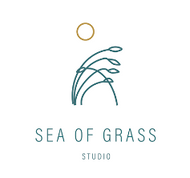Coloured Earth Pigments in collaboration with Sea of Grass Studio
Posted by Sarah, Celtic Sustainables on 23rd Nov 2017
We got together with Donna from ‘Sea of Grass’ to learn more about where it all started and how she came about using Coloured Earth pigments in her products.
"I have been making all my life; before I had children, I made and sold paper and worked alongside my ex-partner in a stone masonry/carving business. I was painting and selling cards and prints a few years ago; customers loved the vibrancy and colours of the paints I was using and had made myself. I made many jars of paint using mini jam jars from a local cafe, and Sea of Grass emerged. The Sea of Grass was an area on the plains of Ukraine many millennia ago, where Asian, European and Celtic came together. I was born into the cultural melting pot of Singapore, with Scottish, Romany and Italian ancestry. I wanted a natural and inclusive name, as the materials come from all corners of the earth."
Where did your inspiration come from making products like natural beeswax crayons and watercolour paints?
I’ve been interested in ecology and sustainably since before I had children. When I became a mother, I wanted my children to have safe, natural and inspiring materials for their creativity, and I began exploring natural paint pigments.
What do you like about the coloured earth pigments? How did you hear about Celtic Sustainables?
I discovered Celtic Sustainables through a friend who had renovated his house and was using sustainable building products. I contacted Anthony about your new range of pigments and had a constructive and enthusiastic response. The content of colours is beautiful and inspiring, the pigments are reasonably priced, and I was impressed with the care that had gone into sourcing and packaging the pigments.
I love the earth's colours and prefer the qualities of natural earth pigments. Still, green sustainable chemistry has created gorgeous, vibrant colours that are often easier to work with.
Do you find the pigments versatile?
So versatile! The coloured earth pigments form the basis of my whole product range, both the paints and crayons and I’m currently working on a range of soft pastels, oil paints and printing inks.
In terms of making, I love the simplicity of the Beeswax Crayons, the process is satisfying, and the wax is melted, so on a cold day, I am warm over the stove. I do love to use my watercolours.
No two batches of paints or crayons are the same, each pigment behaves very differently when making, and different quantities are needed for each colour; you have to feel your way; it’s not prescriptive and can be challenging. Even different batches of the same colour pigment respond differently.
How do you encourage children to be creative and to experiment with colour and materials?
I love supporting and encouraging others with their creativity, and I’ve had requests to do workshops for children and adults; I would like to eventually, but developing the art materials has taken a lot of time.
I can only speak from my experience with my children and their friends. I gave them lots of colourful, tactile, natural materials and lots of table or floor space and experimented alongside them. Offering lots of enthusiastic, positive feedback
Is sustainability a priority in your business frame?
Sustainability is a huge priority and I continually look at ways to achieve this through supplier transparency, recyclability, biodegradability, fair trade, small businesses and low-impact materials, it’s a work in progress.
How did you get into making sketchbooks? How do you find working with natural materials?
I had made sketchbooks with my kids, and a friend introduced me to African Bark fabric. I love its texture, variations in colour and imperfections. My customers enjoy crafts and are professional artists, eco buyers, parents, grandparents and art students.
It’s exciting to be a small part of what someone described as the 'power and goodness of the micro economy'... And I have lots more ideas for handmade products from quality natural materials found globally and made using simple craft processes and sustainable technologies. The artist’s sketchbook uses bark harvested once a year to allow regrowth and pounding to create this unique fair-trade material. It is often handstitched at the source to produce a continuous fabric sheet. The two materials are bound together with waxed eco-hemp twine, and all the materials are from responsible sources.
“I work on natural art papers and use my range of handmade realistic watercolours – made from earth pigments and plant dye – and inks. Making my own materials is an essential part of the creative process.
My original work is also available as limited edition art prints and surface pattern designs on organic fabrics and paper products.”
To see Donna’s Sea of Grass products, including individual watercolour paints and limited edition watercolours, visit her Etsy shop, and you can also see the complete list of products on her website here! We also love following Donna on her Instagram account to keep up with new products and watching the process of her making the actual products.
Since prehistoric times, humans have used natural and mineral pigments to decorate our walls, bodies and possessions. Whether as a means of expression or as a record of events, we have utilised natural colours of nature to adorn the walls of caves and castles alike. Prehistoric cave paintings, rich lime washes, glorious frescos, beautiful oil paintings, refreshing watercolours and inspired egg tempera icons all have pigments in common. Without pigments, there would be no lasting colour. – Coloured Earth Pigments



